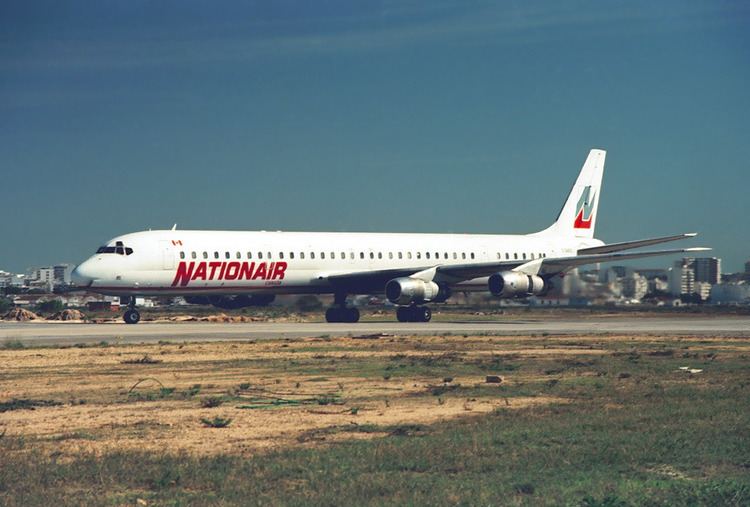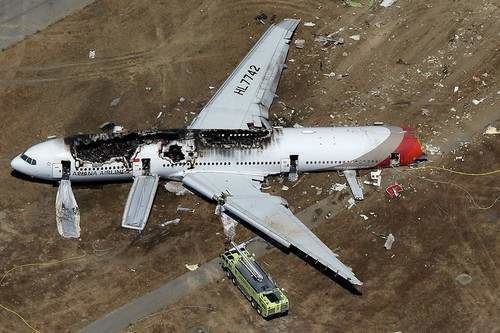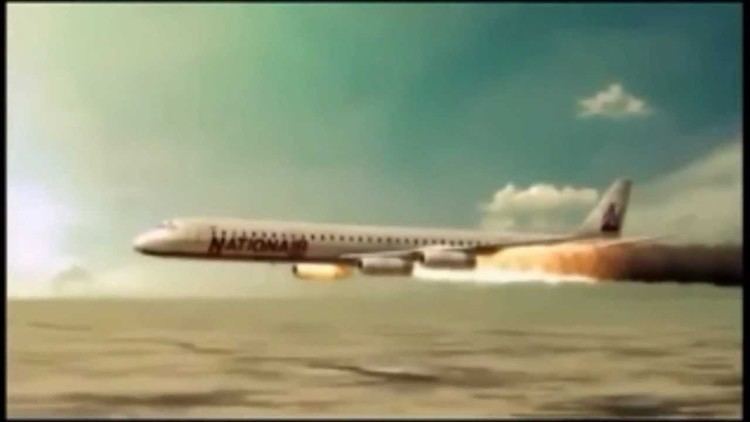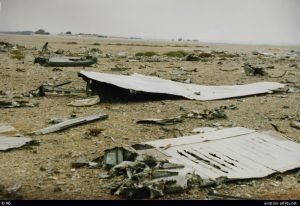Passengers 247 Fatalities 261 (all) Passenger count 247 | Survivors 0 Date 11 July 1991 Survivor 0 Crew count 14 | |
 | ||
Similar Continental Express Flight 2574, Arrow Air Flight 1285, Korean Air Cargo Flight 8509, Pacific Southwest Airlines Fl, West Caribbean Airways F | ||
Nigeria Airways Flight 2120 was a chartered passenger flight from Jeddah, Saudi Arabia, to Sokoto, Nigeria on 11 July 1991 which crashed shortly after takeoff from King Abdulaziz International Airport, killing all 247 passengers and 14 crew members on board. The aircraft was a Douglas DC-8 operated by Nationair for Nigeria Airways. Flight 2120 is the deadliest accident involving a DC-8 and remains the deadliest aviation disaster involving a Canadian airline.
Contents

Aircraft and crew

The aircraft involved in the accident was a 1968-built Douglas DC-8-61, registration C-GMXQ, owned by the Canadian company Nolisair, and usually operated by Nationair; at the time of the accident, it was being wet-leased to Nigeria Airways, which in turn sub-leased it to another company to transport Nigerian pilgrims to and from Mecca. William Allan, the 47-year-old pilot in command, a former Canadian Air Force pilot, had logged 10,700 flight hours and 1000 hours in type. Kent Davidge, the 36-year-old first officer, had logged 8,000 flight hours, of which 550 hours were in type, and Victor Fehr, the 46-year-old flight engineer, had logged 7,500 flight hours, of which 1000 hours were in type. The DC-8 was the primary aircraft type used by the airline.
Accident

The aircraft departed King Abdulaziz International Airport bound for Sadiq Abubakar III International Airport in Sokoto, but problems were reported shortly after takeoff. The crew attempted to return to the airport for an emergency landing, but the aircraft which was already on fire, experienced an inflight break-up, and crashed 2,875 metres (9,432 ft) short of runway 34L. When the aircraft was about 18 kilometres (11 mi) from the airport and at an altitude of 671 metres (2,201 ft), a number of bodies fell from it, indicating that the fire by that time had consumed, at least partially, the cabin floor. All 261 occupants on board—including 247 passengers—perished in the accident. As of July 2014, the accident remains the deadliest crash involving a Douglas DC-8, as well as the second deadliest crash taking place on Saudi Arabian soil, after Saudia Flight 163.
Cause

Prior to departure, the lead mechanic had noticed that the "#2 and #4 tyre pressures were below the minimum for flight dispatch" and attempted to inflate them, but no nitrogen gas was readily available, and the project manager, unwilling to accept a delay, disregarded the problem and readied the aircraft for dispatch. As the aircraft was taxiing, the transfer of the load from the under-inflated No. 2 tire to the No. 1 tire on the same portside axle resulted "in overdeflection, over-heating and structural weakening of the No. 1 tyre." "The No. 1 tyre failed very early on the take-off roll", followed almost immediately by the No. 2. The latter stopped rotating "for reasons not established", and the subsequent friction of the wheel assembly with the runway generated sufficient heat to start a self-sustaining fire. The crew realised there was a problem, but not the nature or seriousness of it. The aircraft was not equipped with fire or heat sensors in the wheel assembly. The first officer was recorded remarking, "We gotta flat tire, you figure?" According to Canadian Transportation Safety Board members interviewed for an episode of Mayday about the accident, standard procedures regarding tire failure during the takeoff roll on the DC-8 did not then (and still did not as of the episode's season 11 airing) include rejecting takeoff for tire or wheel failures, so the captain proceeded with the takeoff.

When the landing gear was retracted, "burning rubber was brought into close proximity with hydraulic and electrical system components", causing the failure of both hydraulic and pressurisation systems that led to structural damage and loss of control of the aircraft. The Transportation Safety Board later concluded, "had the crew left the landing gear extended, the accident might have been averted". Fuel, "probably introduced as a result of 'burn through' of the centre fuel tank", intensified the fire, which eventually consumed the cabin floor. People began falling out of the aircraft when their seat harnesses burned through. "Despite the considerable destruction to the airframe, the aircraft appeared to have been controllable until just before the crash."
Aftermath
Soon after the accident, a group of Toronto-based Nationair flight attendants pooled funds to create a memorial plaque, inscribed with the names of the victims. The memorial, complete with a cherry tree planted to commemorate their colleagues who died in Jeddah, was given a permanent home at the head office of the Greater Toronto Airports Authority.
The aircrash, combined with Nationair's poor reputation for on-time service and mechanical problems, led to serious problems with public image and reliability among tour operators. These difficulties were compounded when Nationair locked out its unionised flight attendants and proceeded to replace them with strikebreakers on 19 November 1991. The lock-out lasted 15 months and by the time it ended in early 1993, Nationair found itself in severe financial trouble. At the time, Nationair owed the Canadian government millions of dollars in unpaid landing fees. Creditors began seizing aircraft and demanded cash up front for services. The company was declared bankrupt in May 1993, owing CDN$75 million.
In 1997, Robert Obadia, owner of Nationair and its parent company Nolisair, pleaded guilty to eight counts of fraud in relation to the company's activities.
Dramatization
An episode of Mayday entitled "Under Pressure" covered this accident.
